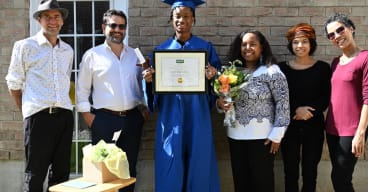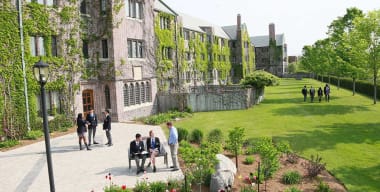
ILLUSTRATION BY DAVE CUTLER
In 2010, Kate Pickett and Richard Wilkinson, two British epidemiologists, published a meta review of university and research centre studies on disease and health distribution, Why Equality is Better for Everyone. Page after page of data comparisons across nations and among nations leaves no doubt: Reducing inequality leads to a stronger, healthier and more viable society across the whole population.
Their data specifically demonstrates that mental and physical health indicators are improved for the entire society, not only lower income people, in countries with higher equality rankings. Meanwhile, mental health illnesses are five times higher across the whole population in nations with greater degrees of inequality. Similar data comparisons hold for violent crimes, imprisonment rates and health factors, such as life expectancy and disease rates.
Given this important information, what role do schools play in building a society with more equality? Independent schools need to be aware of the socio-economic diversity of their own school populations. As with cultural diversity among students, which many independent schools deliberately seek, socio-economic diversity allows students to encounter difference, learn from each other and form new bonds that can transcend divisions in our world.
That said, our schools might rightly maintain that part of their responsibility is to manage a budget that provides the education promised— supported, for the most part, by tuition fees. Nevertheless, balancing the books with a relevant socio-economic and cultural balance needs to be considered.
Bursaries and scholarships that help offset tuition costs are part of almost every independent school. They are a way to attract enrolment, but also a way to help ensure that students of ability but without financial means are able to access the benefits of an independent school education. But are they enough? During my six years as head of school at Queen Margaret's School (QMS), which has a very small endowment for scholarships and bursaries, we looked at ways to increase participation by families that reflected the population of the surrounding community. In Duncan, situated in the Cowichan Valley, the Cowichan First Nation people have a high profile in both the economic and social life of our community.
While some First Nation families are fully able to support their children in our day program, many more cannot. With the support of the local bands, families were able to spend their education allowance on an independent school education, but it fell short of the tuition level required for the school's financial health. Others with First Nation heritage but no local band affiliation were not able to access any funds.
To encourage representation of First Nation or Aboriginal children in the school, QMS used a number of strategies, including policy changes to support band-sponsored day students and a few more-comprehensive scholarships for girls of ability in the secondary school program. The presence of First Nation students in our school meant that First Nation cultures and histories were more likely to be part of curricular topics and activities at the school—built on the real-life experiences of our students.
No matter their size or location, independent schools represent privilege— entitlement to an education with smaller classes, more activities and a strong sense of community. It comes with our responsibility to contribute to building a stronger and healthier society. To do that, we need to think about socio-economic diversity as an important part of our schools. As the evidence shows, it leads to better outcomes for everyone.
How does your school maintain Socio-Economic Diversity in your student population?
HTS does not have unlimited resources, but those we have enable students from lower income households to enrol. Using a system of means-tested financial support, we are able to widen participation and increase socio-economic diversity within the school community.
Toronto is a richly diverse and multicultural city, and our schools play a vital role in bringing people together in an environment that nurtures a climate of inclusion and a respect for diversity. Building on the success of The Sterling Hall School's Nick Holland Scholarship Fund, which is generously funded by an alumni family, the Robinson Family Fund was established in honour of Ian Robinson to celebrate his retirement and accomplishments over the past 17 years at SHS. This fund is a scholarship program for exceptional students who lack the financial means to receive an education at our school. The creation of the Robinson Family Fund allows Sterling Hall to attract and assist boys from a variety of backgrounds, and demonstrates our commitment to creating a more diverse community that is reflective of our broader society.
We continue to build our scholarship and financial aid program to ease the financial commitment of families. We make a conscious effort in our marketing to be more broad ranging. We hope the concept of "Closer Than You Think" will appeal to families that feel our school is out of reach for their children.
By offering over $2.2 million in financial assistance each year, we can ensure that the independent school advantage is not just for the elite class anymore. Most benefactors have set up bursaries for those who might not normally be able to afford the school. Our strategic plan also places a priority on building endowment so that we can offer more bursaries in the future.
Accessibility is a priority. The number of students who receive some form of tuition assistance recently increased from six to eight per cent of the student body, and the year of eligibility dropped to Grade 5. The number will soon increase to 11 per cent, with a strategic plan to reach 20 percent (220 boys) in the coming years.
Our significant commitment to providing bursaries and scholarships means that 25 per cent of our students receive some sort of financial aid and stem from mixed family income levels and backgrounds.
Bursary funds, which have increased by 50 percent over the last four years, enable us to eliminate the tuition barrier for exceptional students who otherwise could not attend Havergal. The school's Board of Governors aims to increase the amount of money raised each year, our parent association initiated an endowed Havergal Community Committee Bursary Fund, and many graduates and former parents have established named bursaries.
What are the benefits of socio-economic diversity?
The Sterling Hall School (THS)
The benefits of attracting the best and the brightest students, regardless of financial circumstances, are many. Scholarships help all students understand points of view different from their own, enrich our classroom discussions, and have a positive impact on student learning and interaction. They help raise the bar for all of our students, and contribute to an academic and social environment at Sterling Hall that is characterized by a culture of respect, empathy, caring and achievement.
Strathcona-Tweedsmuir School
Bringing together students from various backgrounds plays a tremendous role in their personal growth. With globalization on local, national and international levels, it is important that students have the opportunity to communicate across a wide variety of perspectives.
Upper Canada College (UCC)
Not enough funds to assist all those who apply leads to a competitive enrolment process where characteristics such as motivation, leadership, robust academics and co-curricular talents add to and strengthen the student body and school environment. Financial assistance to top students for their achievement prior to entering the school generally encourages them to strive for greater success and opportunities once enrolled. This drive often has an impact on those around them.
Trinity College School (TCS)
The person who has a broad exposure to different backgrounds, cultures and experiences is able to be more successful in today's working world. By ensuring that students are educated in a classroom with students from different countries, cultures, religions and socio-economic profiles, TCS is modeling the real-world requirements once the student moves on into the working world. In a classroom with true diversity, the debates, conversations and points of view are broader and richer.
What is the school's responsibility or role in ensuring it is representative of socio-economic difference?
Havergal College
Bursary funds, which have increased by 50 per cent over the last four years, enable us to eliminate the tuition barrier for exceptional students who otherwise could not attend Havergal. The school's Board of Governors aims to increase the amount of money raised each year, our parent association initiated an endowed Havergal Community Committee Bursary Fund, and many graduates and former parents have established named bursaries.
Their data specifically demonstrates that mental and physical health indicators are improved for the entire society, not only lower income people, in countries with higher equality rankings. Meanwhile, mental health illnesses are five times higher across the whole population in nations with greater degrees of inequality. Similar data comparisons hold for violent crimes, imprisonment rates and health factors.
Raising money to support endowed bursaries is a strategic priority for our school. We make sure that sufficient bursary funds are available to ensure that any mission-appropriate student may attend our school. We adhere to a "needs-blind" admission process; in other words, a student is admitted based solely on her merit and not on her family's ability to pay.
Shawnigan Lake School
Shawnigan is careful to maintain a level of diversity that is a reflection of Canadian culture and the greater global community. Our responsibility is to expose our students to a heterogeneous educational environment so that they can nurture an open-minded approach to the world, a willingness to accept different ways of thinking and an ability to navigate a diverse environment.
HTS
If we, as a country, are to prosper economically and enjoy genuine social cohesion, there is an urgent need to unlock the potential of every student and enable him or her to flourish. In short, we need the creativity, enterprise and scholarship of all our young people in order to create a successful tomorrow.
Educating young people who will live and work in a country that is diverse in terms of culture, faith, ethnicity and social background points to a need to promote equality of opportunity and good relations between people of different socio-economic backgrounds; as such, HTS' staff and student population reflects this important diversity.
Upper Canada College (UCC)
Education is devalued if a student's admissibility is based on financial ability and not on the important criteria we use today, such as student's character, leadership potential and values as well as ability to contribute to campus life both in the classroom and through co-curricular activities. Socio-economic differences better represent real life outside of what would otherwise be considered a much more privileged environment.
Havergal College—Susan R. Groesbeck, principal at Havergal College in Toronto
HTSBarry Hughes, head of school at HTS in Richmond Hill, Ont.
Shawnigan Lake School—Kelly Koepp, communications and marketing associate at Shawnigan Lake School in Shawnigan Lake, BC
Strathcona-Tweedsmuir SchoolB—Bruce Mutch, director of admissions at Strathcona-Tweedsmuir School in Okotoks, Alta.
The Sterling Hall School—Maria Jordan, executive director of advancement, The Sterling Hall School
Trinity College School—Kathy LaBranche, director of admissions at Trinity College School in Port Hope, Ontario.
Upper Canada College—Struan Robertson, executive director of recruitment at Upper Canada College in Toronto










